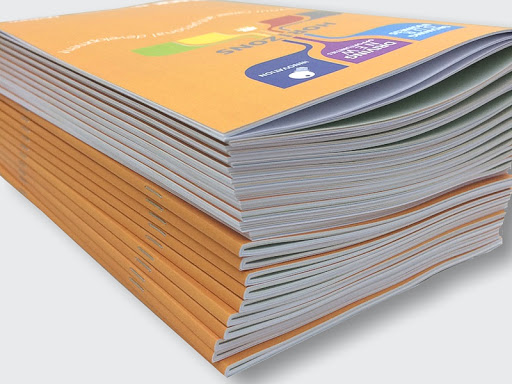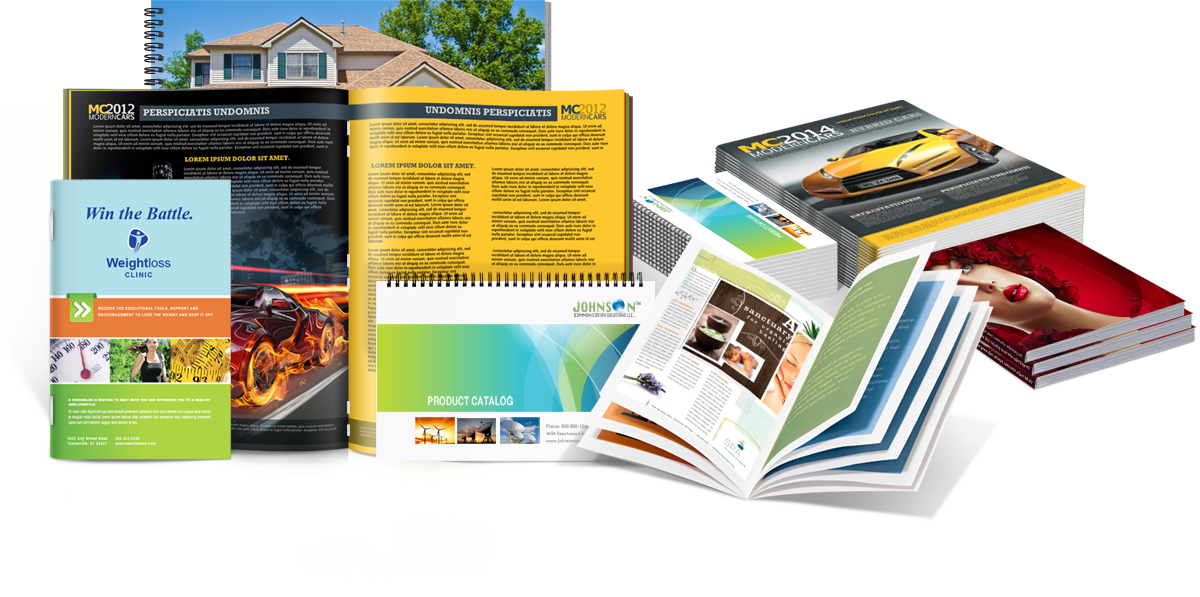A Step-by-Step Guide to Planning a Custom Booklet Printing Campaign
A Step-by-Step Guide to Planning a Custom Booklet Printing Campaign
Blog Article
The Important Guide to Recognizing Pamphlet Printing Options and Techniques
The process of booklet printing entails numerous considerations that can significantly affect the last item. From selecting the appropriate layout and dimension to recognizing the subtleties of binding methods, each choice plays a crucial function. In addition, factors such as paper stock and printing strategies additional influence the effectiveness of the pamphlet. As one navigates these alternatives, it ends up being crucial to grasp just how they interconnect and what that means for the general outcome.
Comprehending Brochure Styles and Dimensions
When thinking about brochure printing, understanding the different formats and sizes readily available is necessary for achieving the desired discussion. Booklets can be created in numerous styles, consisting of saddle-stitched, spiral-bound, and perfect-bound, each offering unique benefits. Typical dimensions vary from common letter (8.5 x 11 inches) to smaller options like A5 (5.8 x 8.3 inches), enabling versatility based upon content and target audience.Selecting the suitable dimension can influence both the format and reader interaction. Bigger dimensions may suit visually driven material, while smaller sized formats may be more straightforward and mobile. Additionally, the number of web pages affects the choice of binding technique, as thicker booklets might require stronger bindings. Eventually, recognizing these aspects permits a more tailored method, making sure that the end product aligns with the designated message and aesthetic, improving the general performance of the interaction.
Choosing the Right Paper Stock

Binding Methods: Factors To Consider and options
When it concerns binding approaches for booklets, several choices are offered, each with distinctive advantages. Saddle stitch binding provides an economical remedy for thinner booklets, while ideal binding techniques offer a more refined seek thicker magazines. Wire-O binding attracts attention for its resilience and simplicity of usage, making it excellent for records that call for versatility.
Saddle Stitch Binding
Saddle stitch binding offers a cost-effective and practical solution for putting together booklets, making it a popular choice among services and authors. This binding approach includes folding sheets of paper in half and stapling them along the fold line, creating a neat and well organized appearance. Usually appropriate for booklets with a lower page count, saddle sewing is excellent for publications, pamphlets, and training products. The simpleness of this method allows for quick production and is typically favored for promotional items or brief runs. Nevertheless, it is vital to note that saddle stitch binding might not appropriate for thicker brochures, as the spine might not hold up under raised weight. Overall, it continues to be a trusted choice for many printing jobs.
Perfect Binding Techniques
Perfect binding is a commonly used strategy that gives a refined and expert finish to magazines and booklets. This approach includes gluing the web pages together at the spine making use of a solid adhesive, allowing for a clean side and the ability to hold a bigger variety of pages contrasted to saddle stitching. Perfect binding is specifically suitable for thicker booklets, such as catalogs and annual records, where a sturdy, flat back is desired. Additionally, it uses the option for a printed cover that can be created to enhance aesthetic appeal. Factors to consider such as web page matter, paper weight, and the intended use of the booklet must be taken right into account, as they can influence sturdiness and total quality.
Wire-O Binding Options
Wire-O binding, known for its sturdiness and adaptability, supplies an outstanding choice for brochures that call for very easy web page turning and an expert appearance. This binding technique utilizes a series of metal loops that hold pages safely, enabling them to lie flat when open. It is particularly ideal for brochures, presentations, and manuals due to its durable nature. Wire-O binding is available in various shades and diameters, fitting different page counts and thicknesses. In addition, it allows the addition of covers and tabs, enhancing the booklet's overall visual. Considerations for Wire-O binding include the selection of cable shade, the dimension of the loops, and the level of modification preferred, all of which can profoundly influence the final item's look and capability.
Digital vs. Offset Printing: Which Is Best for You?
When selecting a printing technique for brochures, understanding the distinctions between electronic and balance out printing is necessary. Digital printing uses modern-day technology to produce top notch prints rapidly and affordably, making it excellent for short runs or tasks needing fast turnaround times. It permits personalization, offering the capacity to print on-demand with very little waste.In contrast, balance out printing is a standard method that succeeds in creating huge quantities with regular quality. It includes transferring ink from a plate to a rubber covering, then to the paper, which leads to accurate information and lively shades. Balance out printing normally requires longer setup times and is much more cost-efficient for bigger volumes.Ultimately, the choice between electronic and balance out printing depends on task needs, budget plan, and wanted amount. For tiny, time-sensitive projects, digital could be the most effective selection, while countered may be more suitable for Source larger, premium productions.

Designing Your Booklet: Tips and Best Practices
When making a pamphlet, cautious focus to layout, typeface choice, and shade usage can substantially boost its performance. A well-structured design guides the reader's eye, while sites suitable fonts assure readability and communicate the preferred tone. Additionally, reliable use color can stimulate emotions and highlight essential details, making the general style much more impactful.
Picking the Right Format
Just how can one successfully choose the right design for a booklet? It is vital to evaluate the brochure's purpose and target audience. A tidy, arranged design boosts readability and interaction. Making use of a grid system can aid in lining up elements constantly, creating an expert look. Additionally, including aesthetic pecking order via differing sizes and placements of pictures and message can guide the visitor's eye and highlight crucial information. It is likewise vital to leave adequate white room, which prevents congestion and enables for far better focus. Evaluating various formats through mock-ups can offer understanding into exactly how the layout executes in real-world scenarios, making sure that the last item fulfills both functional and aesthetic requirements. Practical Choosing Proper Typefaces
An appropriate font can significantly improve the general style of a brochure, matching the layout and strengthening the material's message. The choice of font styles ought to think about readability, particularly for body message, as it assures the details comes to all viewers. Sans-serif typefaces are usually chosen for digital formats, while serif fonts can offer a typical feeling in printed materials. It's advisable to limit font selections to 2 or three to maintain aesthetic coherence. Additionally, font dimension plays a crucial function; headings should be not frustrating however distinct, while body message need to be comfy for reading. When selecting fonts, alignment with the pamphlet's style and target audience is essential for reliable communication and aesthetic allure.
Effective Usage of Shade
Shade serves as an effective device in pamphlet layout, assisting and shaping perceptions reader emotions. It can evoke feelings of excitement, trust, or peace, depending on the colors picked. Designers ought to consider shade concept principles, guaranteeing that the selected scheme aligns with the brochure's message and target market. Utilizing cozy shades like red and orange can develop necessity, while cooler tones like eco-friendly and blue foster tranquility.Additionally, comparison plays a vital role; complementary colors can enhance readability and visual allure. Uniformity in shade use throughout web pages additionally enhances brand name identity and cohesion. Ultimately, efficient color execution not only catches attention but also reinforces the pamphlet's purpose, making it a necessary element of successful style.
Finishing Touches: Coatings and Special Results
While lots of take into consideration the web content and design of a brochure the most critical elements, the completing touches, such as finishings and special effects, play an essential duty in improving its general charm. Coatings can offer protection and durability, making certain that the pamphlet endures wear and tear. Matte coatings supply a sophisticated, non-reflective surface, while shiny finishes can make shades show up even more vivid and captivating. Unique impacts, like embossing or aluminum foil marking, add a responsive dimension that can create a remarkable impression. These strategies can highlight certain areas, accentuating vital information or developing aesthetic rate of interest. Additionally, UV finishing can give a high-shine coating that raises the total look.Together, these completing touches not just enhance the pamphlet's aesthetic however additionally interact professionalism and interest to information, eventually leaving a long-term influence on the viewers.
Cost Considerations for Pamphlet Printing
Understanding the numerous cost considerations for pamphlet printing is important for services and companies intending to optimize their budgets. Secret variables influencing expenses consist of the choice of binding, paper, and ink methods. Better materials, such as superior paper or specialized inks, typically enhance the general expense. Furthermore, the size and page matter of the brochure play a substantial duty; bigger pamphlets require even more sources and time to produce.Another essential consideration is the printing method, whether digital or balanced out, as each has its own prices structure and viability for various amounts. Organizations need to additionally consider layout prices, which can vary based upon intricacy and using specialist solutions. Eventually, shipping and handling costs can include to the overall, particularly for huge orders. By evaluating these aspects, organizations can make informed decisions that align with their economic capacities while accomplishing the wanted high quality in their printed materials.
Regularly Asked Inquiries
What Are the Ecological Effects of Brochure Printing?
The environmental impacts of pamphlet printing consist of deforestation from paper production, carbon discharges from transportation, and waste generation from thrown out products - Booklet Printing. Lasting methods, such as using recycled paper and environmentally friendly inks, can minimize these impacts
How Can I Ensure Shade Accuracy in My Booklet?
To guarantee shade precision in a booklet, one should make use of calibrated displays, utilize specialist color accounts, carry out examination prints, and choose premium printing solutions that use color matching and proofing choices for best outcomes.
What Is the Common Turn-around Time for Brochure Printing?
The common turn-around time for brochure printing differs depending upon the intricacy and quantity - Booklet Printing. Generally, it ranges from a few days to 2 weeks, influenced by aspects such as publishing techniques and completing requirements
Are There Minimum Order Quantities for Pamphlet Printing?

Can I Print Brochures in Several Languages?
Publishing pamphlets in numerous languages published here is feasible. Many printing solutions supply options for multilingual or bilingual layouts, allowing for efficient communication. Cautious preparation assurances that create components suit numerous languages without endangering readability or looks. In addition, variables such as paper supply and printing strategies more affect the efficiency of the booklet. When thinking about pamphlet printing, comprehending the different styles and sizes available is important for attaining the wanted discussion. When choosing a printing method for booklets, recognizing the distinctions between digital and balance out printing is important. Additionally, the dimension and web page count of the booklet play a significant role; bigger brochures require even more sources and time to produce.Another essential consideration is the printing technique, whether digital or countered, as each has its own pricing framework and viability for different quantities. The environmental effects of pamphlet printing consist of deforestation from paper manufacturing, carbon emissions from transport, and waste generation from thrown out materials.
Report this page